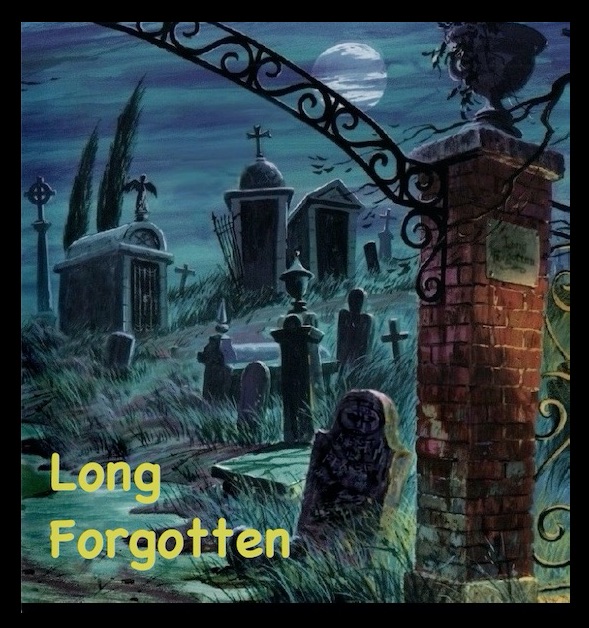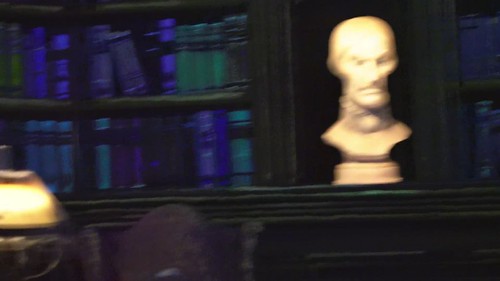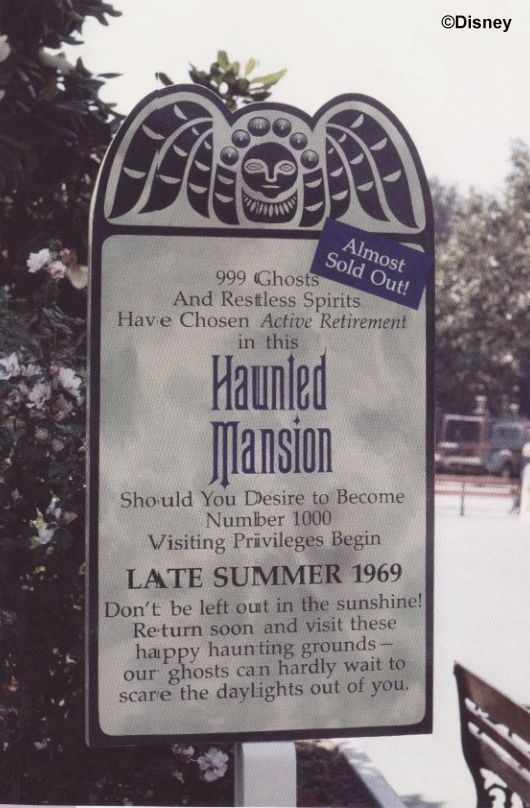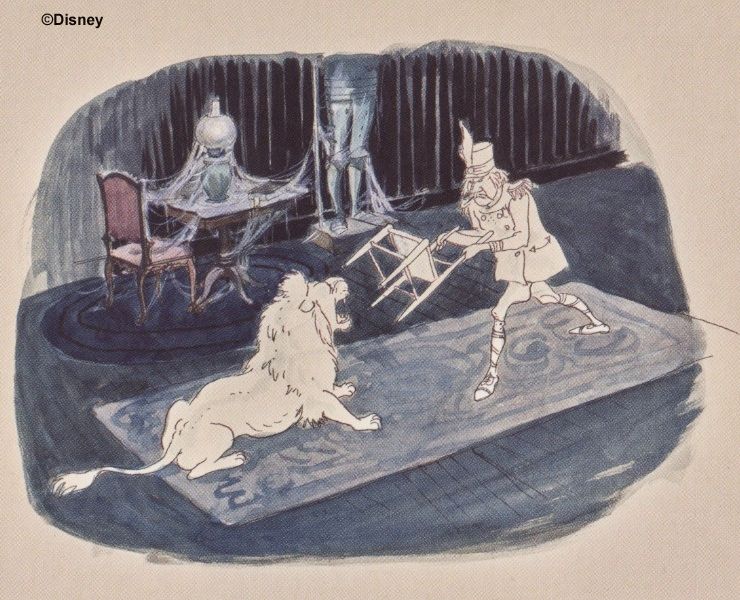In the last post I reviewed the 1963 thriller, The Haunting, a film of special interest to us inasmuch as it was a major source of inspiration for the Haunted Mansion. Earlier this year we had already exhumed The Haunting for a fresh reexamination and found some previously unnoticed connections between the film and the ride. Time now to look at three other must-see (and by Imagineers certainly-seen) haunted house flicks: The Uninvited, 13 Ghosts, and The Innocents. No toes shall be trodden upon this time, I promise.
The Uninvestigated
Foxxy's survey of pre-Mansion screen horror makes only a passing allusion to The Uninvited (1944), which is puzzling. This appears to be Hollywood's first attempt at telling a haunted house story with a straight face. The premise is not debunked or played for laughs; instead, we have a well-told tale about a lonely mansion with a mysterious past that is home to some real ghosts. It was a hit. Some consider it the finest haunted house movie ever made. The ending is a little too warm and fuzzy for my tastes, and the scares are not as intense as those in The Haunting or The Innocents, but it's a very good movie.
Now, to business. Is there anything in The Uninvited that looks like it could have been a creative influence on the Haunted Mansion? I'm going to say yes. To begin with a general observation, I think it's more likely than not that the HM Imagineers took a look at "Windward House" in order to get one interpretation of what a haunted house is supposed to look like. Windward House is in fact the sort of nicely kept, attractive building that Walt demanded, so the film has always provided proof that people would accept a haunted house that didn't look like a Halloween poster.
The entry to Ken Anderson's Ghost House is undeniably similar to the one in Windward House in several ways. He conceived of a front door opening into a big room that transformed the rectangular space into a large oval, with a twisting staircase in the center rising to a balconied second floor. In both houses the look is classic Baroque rather than some form of "haunted house Gothic."
Pamela looked at Robert and said in a tone almost apologetic, "They say this matte painting is
haunted, but it certainly doesn't look like a haunted matte painting." There was a look of puzzled
apprehension in her eyes. Robert shrugged and said in a voice strangely lacking in conviction, "I
don't believe in haunted matte paintings; there's always a logical explanation for these things." He
suddenly turned accusatory. "You've been reading too many stories about haunted matte paintings."
Pam stood her ground: "You have to admit that pretty strange things go on in some matte paintings."
Just then a shot rang out, followed by a long scream! "Quick, inside that matte painting!" cried Robert.
Pam stood her ground: "You have to admit that pretty strange things go on in some matte paintings."
Just then a shot rang out, followed by a long scream! "Quick, inside that matte painting!" cried Robert.
Okay, Windward House may owe its exterior existence to a paint brush, but it's what's inside that counts, and the house's interior architecture reminds me of concept art produced by Ken Anderson and by Claude Coats. You can judge for yourselves as we go along.
The entry to Ken Anderson's Ghost House is undeniably similar to the one in Windward House in several ways. He conceived of a front door opening into a big room that transformed the rectangular space into a large oval, with a twisting staircase in the center rising to a balconied second floor. In both houses the look is classic Baroque rather than some form of "haunted house Gothic."
Unlike Windward House, however, the central opening in Anderson's room was
essentially a hole in the ceiling, and the staircase continued up for three floors.
Nevertheless, in one well-known Anderson concept sketch, the look of that stairwell is eerily similar to shots of the Windward House staircase seen throughout the movie, suggesting that visual images from The Uninvited may have exerted an influence, consciously or unconsciously. That sounds pretty mushy, but take a look. There is no denying the striking similarities.
We turn next to one of Claude Coats' best known Mansion artworks, and here again you
have to wonder if the balconies and railings of Windward House may have left an impression.
Coats had architectural training and was as involved in that aspect of the ride as in any other.
Coats had architectural training and was as involved in that aspect of the ride as in any other.
Beyond these admittedly airy architectural assessments, do we have anything that looks like a rock solid contribution? I'd say yes, it's safe to say that there's at least one Mansion gag taken directly from The Uninvited. As many of you know, the library scene in the Tokyo Haunted Mansion is far busier with ghostly activity than its Florida twin. For one thing, there's a book lying open on the table with a ghost flipping through it, a simple yet beautifully done effect.
In The Uninvited, a journal left on a writing desk is rifled through by one of the ghosts, hoping to
expose Windward's new owners to an important clue for solving the mystery of the house. The poor ghost
has to do this three or four times in a couple of different scenes before someone finally notices it.
Not only is the gag the same, but no doubt it is accomplished in exactly the same way (with fans, dummy). I'd be truly surprised if this Haunted Mansion effect was not directly inspired by The Uninvited.
Even if this gag only goes back to the early 1980s, when the Tokyo HM was in development, it could still be a contribution from one of the original HM Imagineers, because some of them also worked on the Tokyo version. But it doesn't matter, because it's also possible that later Imagineers were inspired by The Uninvited. One place you may see such a thing is on the animated Leota gravestone at WDW, installed in 2002. Above the fireplace at Windward House is a carving that is strikingly similar to the figure of Leota. See for yourself. The resemblance is uncanny, but on the other hand it is in some ways a pretty generic "classical" face, but on the other hand this particular face is found in a haunted house, but . . . and now I've run out of hands, so I'll just say that the Leota tombstone is presently down in my book in the "solid maybe" column and let it go at that.
Even if this gag only goes back to the early 1980s, when the Tokyo HM was in development, it could still be a contribution from one of the original HM Imagineers, because some of them also worked on the Tokyo version. But it doesn't matter, because it's also possible that later Imagineers were inspired by The Uninvited. One place you may see such a thing is on the animated Leota gravestone at WDW, installed in 2002. Above the fireplace at Windward House is a carving that is strikingly similar to the figure of Leota. See for yourself. The resemblance is uncanny, but on the other hand it is in some ways a pretty generic "classical" face, but on the other hand this particular face is found in a haunted house, but . . . and now I've run out of hands, so I'll just say that the Leota tombstone is presently down in my book in the "solid maybe" column and let it go at that.
UPDATE: A friend points out that the Leota face does indeed seem to reflect a
standard design. You find it elsewhere. Here it is on a 19th c. mirror handle:
standard design. You find it elsewhere. Here it is on a 19th c. mirror handle:
At the end of the day, when it comes to possible influence on the Haunted Mansion, The Uninvited is pretty small
potatoes when compared to The Haunting. Still, it's probably safe to say that it provided some inspiration for the ride.
potatoes when compared to The Haunting. Still, it's probably safe to say that it provided some inspiration for the ride.
13 Ghosts
It's 1960 and William Castle has found yet another way to suck loose change out of kids' pockets. This time it's a low-budget haunted house flick filmed in "Illusion-O," a typically schlocky Castle gimmick. The story in 13 Ghosts is pretty silly, and the special effects are only "special" in the same sense as "Special Olympics," but all is forgiven, because it's entertaining enough to carry you the necessary 84 minutes. Your eyes shall roll, but there are one or two legitimate scares (although not from the ghosts), and it's got a nice twist ending (even if it gets started a little too early). You also get a darn good performance from 11-year old Charles Herbert, a 21-year old Jo Morrow to ogle, and of course, the lovely Margaret Hamilton at no extra charge. Oh, and there's the telegram delivery guy near the beginning. Damn, he's good.
If such be not enough to persuade you, listen as the Ghost Host himself enthusiastically recommends the film:
I mentioned this one very briefly in our first Creepy Old Flicks post, but I must confess that I had not seen the movie in its entirety and merely passed on some observations by Disney historian Ed Squair. Seeing as how we know with certainty that Walt and some of his Imagineers saw the film together, I finally broke down and got a copy and did a little investigating of my own, like I should have in the first place. Yowza, I wish I had seen 13 Ghosts earlier, because I now think this film was a major influence in defining the Haunted Mansion. In fact, the film and the ride have a couple of things in common so big and so obvious that no one has noticed them. Here's the first:
The house in 13 Ghosts is haunted because some guy went out and collected ghosts from all over the
world and brought them there, some of them scary and some of them silly in a macabre sort of way.
world and brought them there, some of them scary and some of them silly in a macabre sort of way.
That is, of course, the basic premise of the Haunted Mansion as well. And remember, this was originally Walt's idea. Here he is in 1965:
"We haven't got the ghosts in there yet, but, we're out collecting the ghosts. We're going to bring ghosts from all over the
world, and we're making it very attractive to them, hoping, you know, that they'll want to come and stay at Disneyland."
world, and we're making it very attractive to them, hoping, you know, that they'll want to come and stay at Disneyland."
Actually, Walt was already halfway there by the time he saw 13 Ghosts. In 1958 he had given an interview for the BBC, expressing his sympathies for all the ghosts displaced from their ancestral homes by the London blitz and the new construction which followed. Knowing that ghosts by their very nature need an audience, he issued an invitation to homeless spirits everywhere to come to the retirement home he was going to build for them in Disneyland. What 13 Ghosts added to this was the idea of aggressively going out and collecting the ghosts rather than merely extending a passive invitation and hoping for the best.
Since we know Walt watched the movie with the express purpose of looking for usable ideas, you can easily imagine him thinking, "Hey, that's good. Ghosts collected from all over the world. We can use that." The idea was put to immediate use, too. It's probably no coincidence that the future attraction was regularly described as "the world's greatest collection of ghosts," beginning with the 1961 souvenir guide book. That was the first time the public was told anything specific about the character of the Haunted House. In a 1962 brochure, we find Walt's "talent scouts" out there "searching" and "gathering," collecting occupants for what is now called the Haunted Mansion.
Since we know Walt watched the movie with the express purpose of looking for usable ideas, you can easily imagine him thinking, "Hey, that's good. Ghosts collected from all over the world. We can use that." The idea was put to immediate use, too. It's probably no coincidence that the future attraction was regularly described as "the world's greatest collection of ghosts," beginning with the 1961 souvenir guide book. That was the first time the public was told anything specific about the character of the Haunted House. In a 1962 brochure, we find Walt's "talent scouts" out there "searching" and "gathering," collecting occupants for what is now called the Haunted Mansion.
If Walt thought borrowing the premise of 13G was a good idea, Dick Irvine apparently thought it was a GREAT idea. Irvine was VP of Design at WED (WDI) from 1952 until 1973. Basically, that means he was in charge of all the Disneyland attractions.
He was the boss to whom the HM Imagineers were immediately accountable, and he had ideas of his own that were sometimes thrown into the creative mix. Squair suspects that Irvine came up with a way to use the suffocating canopy bed gag after seeing it in 13 Ghosts, where it plays a major role (although Ken Anderson had already used it in one of his Ghost House scripts from 1957-58). I think Irvine took more than an isolated gag: He took the premise of 13 Ghosts and ran further with it than either Walt or the others did.
The ghost-collecting scientist in 13 Ghosts is said to have captured the ghosts, using a viewing device that gave him a certain mastery over them. Meanwhile, the aforementioned "Illusion-O" consisted of printing red ghosts against a blue background in the film, so that when the audience viewed them with a red filter they were visible, while the blue filter hid them. You were handed a viewing device with the two filters when you bought your ticket. (By the way, the gimmick works, although you can see them without the red filter, just not as clearly.)
Irvine came up with his own idea for a ghost-capturing device. It was a trap baited with something he called "nectarplasm" or "nectoplasm." The ghost dematerialized, went in to the trap, drank the nectoplasm, changed color, and was now visible and unable to de-materialize. That's how the Mansion would get its ghosts, see? With his hokey capturing device and color-changing ghosts for purposes of visibility, Irvine was simply adapting the formula of 13 Ghosts in greater detail. Mercifully, his idea was not used. Ye gods, I think Irvine out-Castled Castle with this one.
13 Ghosts may well have been the inspiration for another major concept: the idea of numbering your spooks. What is more basic to the Haunted Mansion than the fact that it has 999 ghosts? Even better, the numbers serve almost exactly the same function in both the movie and the ride. As you know, there are 999 ghosts in the HM, but there's room for an even thousand, and the thousandth could be you if you aren't careful. In 13 Ghosts there are actually only twelve for almost the entire film, but it's made explicitly clear that there are destined to be thirteen. The question is, which of the living characters is going to end up as the unlucky thirteenth? (You don't find out until the end.) It's another match if you ask me.
As a matter of fact, the adaptation may originally have been even more precise. Already in 1962, Disney publications began claiming that the Mansion will be home to "1001 'actively retired' ghosts," perhaps following the lead of 13 Ghosts in numbering ahead of time the house's final occupant (will YOU be the destined 1001st?). If that's how the number was going to be understood, then eventually someone realized that the gag is clearer and works better if you simply start with the current census and mutter menacingly about adding one more (999 at present, but room for a thousand, bwahahaha). The earliest reference to 999 ghosts I have seen is in the 1968 Disney Annual Report, alongside one of the publicity shots of the Hatbox Ghost prototype and Yale Gracey.
The 999 thing got more public notice when these signs went up, early in 1969.
So it looks as though we have William Castle to thank for giving us (1) a house haunted by an international collection of ghosts, (2) ominously
numbered with a spot reserved for one more. Those contributions are the biggees, but there are also a few littlees. I think you can make a
case that Marc Davis got some ghost ideas from 13 Ghosts. For example, at one point Davis sketched a ghost lion and lion tamer.
That's a concept so far off the beaten path that I think it's safe to say he got the idea from 13 Ghosts:
Like ALL the ghosts, they look better in the artwork used for the posters and the opening credits than they do in the movie.
And as long as we're looking at the lion ghost artwork, I'll put up this Davis
sketch as well, without comment. You can make up your own minds. Strictly fwiw.
sketch as well, without comment. You can make up your own minds. Strictly fwiw.
Anyway, back to the lion tamer. Since Davis's idea was not used, the fact that it happened to have been inspired by 13 Ghosts is pretty minor
league trivia. Ah, but once we concede that Davis took one ghost idea from the film, the door is open to the possibility that he borrowed
others. We might be able to solve a little mystery associated with the popular Magic from the Haunted Mansion souvenir book.
On page 46 there is an illustration that has long puzzled Mansion fans. It appears to be a sketch of the hanging Ghost Host character,
except that it's female! There is no evidence anywhere else that this gender was ever considered for the role, so . . . what gives?
A lot of the sketches in this book were based directly on Marc Davis concept art, as we have seen before.
If this one was too, then it may not depict the figure in the stretching gallery at all but an entirely
separate character. It may in fact be a Davis adaptation of #8 in the 13 Ghosts artwork.
Here's a side-by-side. I'm impressed with the way the hat seems to mimic the hair and the rib cage
seems to mimic the clothing on the 13G ghost. But as always, you can make up your own minds.
seems to mimic the clothing on the 13G ghost. But as always, you can make up your own minds.
Lastly, we have seen that Davis wanted to include a decapitated knight in the HM but seemed to have trouble finding a good way to incorporate him. According to our reconstruction, the breakthrough came when Davis turned the Jailer-and-Prisoner duo into a trio by making the jailer an executioner as well, thus permitting the decapitated knight to join the ensemble. It's only speculation, but I wonder if the fact that one of the 13 Ghosts is a headsman may have triggered this happy idea. After all, it's not as if "the ghostly headsman" is a stock character.
All in all, not bad for a trashy little horror flick.
The Innocents
This 1961 adaptation of Henry James' The Turn of the Screw is on everyone's list of "best all-time haunted house movies," and it's at the top of not a few of them. It holds up beautifully after all these years, and I think it deserves its reputation. Very scary, thanks in large part to stunningly good performances by the two children (Pamela Franklin and Martin Stephens). They'll creep you out every time.
The Imagineers must have seen it, but did it influence the Mansion in any way? Meh. This time the results are meager indeed. The only thing that looks to me like it may have contributed something is the chilling scene about two-thirds of the way through the film in which the governess (Deborah Kerr) hears strange sounds and decides to investigate. Up the stairs she goes, no safety bar in sight, clutching her candelabrum . . .
There's a hallway up there with many doors, and as she proceeds she continues to hear strange sounds, voices that whisper and echo, and distorted laughter. She's sure the sounds are coming from the various rooms as she passes along, and she tries the doors. Some are locked, some are not. Whenever she does open a door, the sounds cease. It seems the ghosts are playing with her.
In some ways, this hallway scene is much closer to the Mansion's Corridor of Doors than the hallways of Hill House in The Haunting. Consider this: In both The Innocents and the Mansion we have weird sounds, voices, and ghostly laughter emanating from behind each door in an upstairs hallway as we wend our way past. Plus, some of the creaking and rattling sounds are also similar to what we hear in the COD, although I wouldn't press this detail too hard. After all, a creaking door is a creaking door is a creaking door. As always, judge for yourselves:
Creepy Sounds from the hallway of doors in The Innocents
Creepy Sounds from the Corridor of Doors in the Haunted Mansion
It's quite possible that this scene served as an inspiration not only for the Haunted Mansion but for The Haunting, which came out two years later. Apart from this one scene, however, I can't see anything in The Innocents that looks like an influence.
***********************
That's enough movies for awhile. Next time, it's back to the Mansion as we try to
imagine how an idea that wasn't used would have been used if it had been used.
imagine how an idea that wasn't used would have been used if it had been used.










